check engine light YAMAHA XT1200Z 2013 Owners Manual
[x] Cancel search | Manufacturer: YAMAHA, Model Year: 2013, Model line: XT1200Z, Model: YAMAHA XT1200Z 2013Pages: 108, PDF Size: 2.86 MB
Page 6 of 108

TABLE OF CONTENTSSAFETY INFORMATION ..................1-1
DESCRIPTION ..................................2-1
Left view ..........................................2-1
Right view ........................................2-2
Controls and instruments.................2-3
INSTRUMENT AND CONTROL
FUNCTIONS .......................................3-1
Immobilizer system .........................3-1
Main switch/steering lock ................3-2
Indicator lights and warning lights ............................................3-4
Multi-function meter unit .................3-8
D-mode (drive mode) ....................3-15
Handlebar switches ......................3-16
Clutch lever ...................................3-18
Shift pedal .....................................3-18
Brake lever ...................................3-19
Brake pedal ..................................3-20
ABS ..............................................3-20
Traction control system ................3-21
Fuel tank cap ................................3-23
Fuel ...............................................3-23
Fuel tank breather hose and overflow hose ............................3-24
Catalytic converter ........................3-25
Rider seat .....................................3-25
Adjusting the rider seat height ......3-26
Windshield ....................................3-28
Adjusting the front fork ..................3-28 Adjusting the shock absorber
assembly ................................... 3-30
Carriers ........................................ 3-31
Luggage strap holders ................. 3-32
Sidestand ..................................... 3-32
Ignition circuit cut-off system ........ 3-33
Auxiliary DC jack .......................... 3-35
FOR YOUR SAFETY –
PRE-OPERATION CHECKS ............. 4-1
OPERATION AND IMPORTANT
RIDING POINTS ................................. 5-1
Starting the engine ......................... 5-1
Shifting ........................................... 5-2
Tips for reducing fuel consumption ............................... 5-3
Engine break-in .............................. 5-3
Parking ........................................... 5-4
PERIODIC MAINTENANCE AND
ADJUSTMENT ................................... 6-1
Owner’s tool kit ............................... 6-2
Periodic maintenance chart for the
emission control system ............. 6-3
General maintenance and
lubrication chart .......................... 6-4
Removing and installing cowlings ...................................... 6-8
Checking the spark plugs ............. 6-10
Engine oil and oil filter cartridge ... 6-11 Final gear oil ................................ 6-14
Coolant ........................................ 6-15
Air filter element ........................... 6-16
Checking the engine idling
speed ........................................ 6-17
Checking the throttle grip free play ........................................... 6-17
Valve clearance ........................... 6-17
Tires ............................................. 6-18
Spoke wheels .............................. 6-20
Clutch lever .................................. 6-20
Checking the brake lever free
play ........................................... 6-21
Brake light switches ..................... 6-21
Checking the front and rear brake
pads .......................................... 6-22
Checking the brake fluid level ...... 6-22
Changing the brake and clutch
fluids ......................................... 6-24
Checking and lubricating the
throttle grip and cable ............... 6-24
Checking and lubricating the brake and shift pedals .............. 6-24
Checking and lubricating the brake and clutch levers ............ 6-25
Checking and lubricating the
centerstand and sidestand ....... 6-26
Lubricating the swingarm pivots ........................................ 6-26
Checking the front fork ................. 6-27
Checking the steering .................. 6-27U23PE3E0.book Page 1 Monday, July 30, 2012 8:44 AM
Page 19 of 108

INSTRUMENT AND CONTROL FUNCTIONS
3-4
3
EAU49392
Indicator lights and warning
lights
EAU11030
Turn signal indicator lights “ ”
and “ ”
The corresponding indicator light flash-
es when the turn signal switch is
pushed to the left or right.
EAU11060
Neutral indicator light “ ”
This indicator light comes on when the
transmission is in the neutral position.
EAU11080
High beam indicator light “ ”
This indicator light comes on when the
high beam of the headlight is switched
on.
EAU11254
Oil level warning light “ ”
This warning light comes on if the en-
gine oil level is low.
The electrical circuit of the warning light
can be checked by turning the key to
“ON”. The warning light should come
on for a few seconds, and then go off.
If the warning light does not come on
initially when the key is turned to “ON”,
or if the warning light remains on, have
a Yamaha dealer check the electrical
circuit.
TIP●
Even if the oil level is sufficient, the
warning light may flicker when
riding on a slope or during sudden
acceleration or deceleration, but
this is not a malfunction.
●
This model is also equipped with a
self-diagnosis device for the oil
level detection circuit. If a problem
is detected in the oil level detection
circuit, the following cycle will be
repeated until the malfunction is
corrected: The oil level warning
light will flash ten times, then go off
for 2.5 seconds. If this occurs,
have a Yamaha dealer check the
vehicle.
EAU49424
Coolant temperature warning
light “ ”
This warning light comes on if the en-
gine overheats. If this occurs, stop the
engine immediately and allow the en-
gine to cool.
The electrical circuit of the warning light
can be checked by turning the key to
“ON”. The warning light should come
on for a few seconds, and then go off.
1. Engine trouble warning light “ ”
2. Oil level warning light “ ”
3. Traction control system indicator/warning light “TCS”
4. Left turn signal indicator light “ ”
5. Anti-lock Brake System (ABS) warning light “ ”
6. High beam indicator light “ ”
7. Neutral indicator light “ ”
8. Coolant temperature warning light “ ”
9. Immobilizer system indicator light
10.Right turn signal indicator light “ ”
6
10
789
12345
ABS
U23PE3E0.book Page 4 Monday, July 30, 2012 8:44 AM
Page 20 of 108
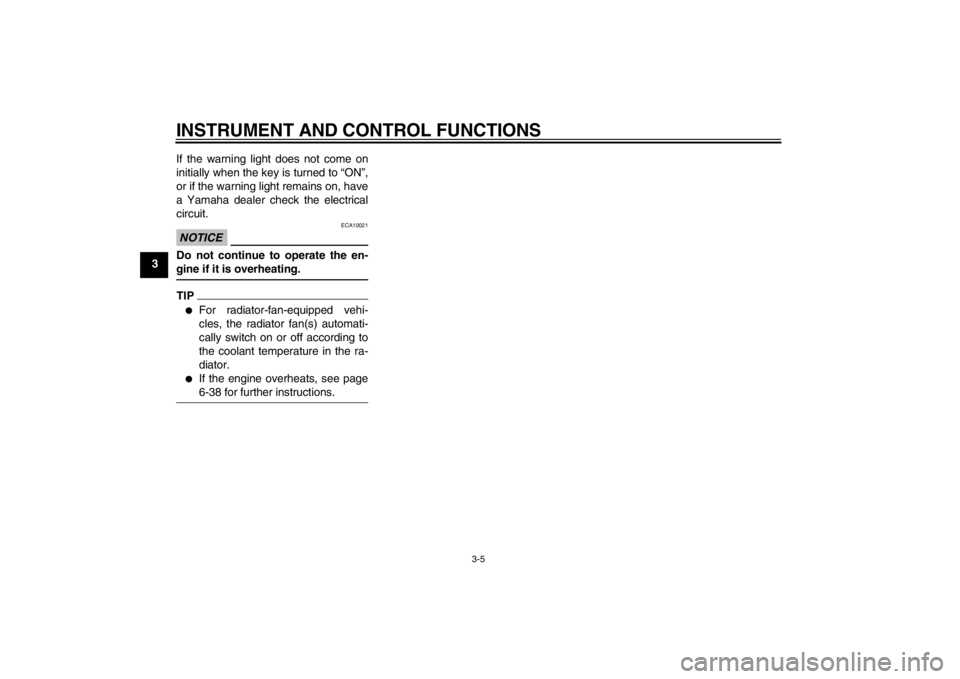
INSTRUMENT AND CONTROL FUNCTIONS
3-5
3If the warning light does not come on
initially when the key is turned to “ON”,
or if the warning light remains on, have
a Yamaha dealer check the electrical
circuit.
NOTICE
ECA10021
Do not continue to operate the en-
gine if it is overheating.TIP●
For radiator-fan-equipped vehi-
cles, the radiator fan(s) automati-
cally switch on or off according to
the coolant temperature in the ra-
diator.
●
If the engine overheats, see page
6-38 for further instructions.
U23PE3E0.book Page 5 Monday, July 30, 2012 8:44 AM
Page 22 of 108

INSTRUMENT AND CONTROL FUNCTIONS
3-7
3
EAU11534
Engine trouble warning light “ ”
This warning light comes on or flashes
if a problem is detected in the electrical
circuit monitoring the engine. If this oc-
curs, have a Yamaha dealer check the
self-diagnosis system. (See page 3-14
for an explanation of the self-diagnosis
device.)
The electrical circuit of the warning light
can be checked by turning the key to
“ON”. The warning light should come
on for a few seconds, and then go off.
If the warning light does not come on
initially when the key is turned to “ON”,
or if the warning light remains on, have
a Yamaha dealer check the electrical
circuit.
EAU51661
ABS warning light “ ”
In normal operation, the ABS warning
light comes on when the key is turned
to “ON”, and goes off after traveling at a
speed of 10 km/h (6 mi/h) or higher.
If the ABS warning light:●
does not come on when the key is
turned to “ON”
●
comes on or flashes while riding
●
does not go off after traveling at a
speed of 10 km/h (6 mi/h) or higher
The ABS may not work correctly. If any
of the above occurs, have a Yamaha
dealer check the system as soon as
possible. (See page 3-20 for an expla-
nation of the ABS.)WARNING
EWA16040
If the ABS warning light does not go
off after traveling at a speed of 10
km/h (6 mi/h) or higher, or if the
warning light comes on or flashes
while riding, the brake system re-
verts to conventional braking. If ei-
ther of the above occurs, or if the
warning light does not come on at
all, use extra caution to avoid possi-
ble wheel lock during emergency
braking. Have a Yamaha dealer
check the brake system and electri-
cal circuits as soon as possible.TIPIf the start switch is pushed while the
engine is running, the ABS warning
light will come on, but this is not a mal-
function.
EAU49402
Traction control system indica-
tor/warning light “TCS”
This indicator/warning light flashes
when the traction control system en-
gages.
The electrical circuit of the light can be
checked by turning the key to “ON”.
The light should come on for a few sec-
onds, and then go off.
If the light does not come on initially
when the key is turned to “ON”, or if the
light remains on, have a Yamaha deal-
er check the electrical circuit.
When the traction control system
switch is set to “TCS” modes “1” or “2”,
and the traction control system is oper-
ating, the indicator light flashes.
If the traction control system disables
while riding, “TCS” “Off” is displayed,
and the indicator/warning light and en-
gine trouble warning light come on.
(See page 3-21 for an explanation of
the traction control system.)
ABS
U23PE3E0.book Page 7 Monday, July 30, 2012 8:44 AM
Page 23 of 108

INSTRUMENT AND CONTROL FUNCTIONS
3-8
3
Try to reset the traction control system
and the lights by following the proce-
dures under “Resetting” on page 3-22.
EAU38624
Immobilizer system indicator light
The electrical circuit of the indicator
light can be checked by turning the key
to “ON”. The indicator light should
come on for a few seconds, and then
go off. If the indicator light does not come on
initially when the key is turned to “ON”,
or if the indicator light remains on, have
a Yamaha dealer check the electrical
circuit.
When the key is turned to “OFF” and 30
seconds have passed, the indicator
light will start flashing indicating the im-
mobilizer system is enabled. After 24
hours have passed, the indicator light
will stop flashing, however the immobi-
lizer system is still enabled.
The self-diagnosis device also detects
problems in the immobilizer system cir-
cuits. (See page 3-14 for an explana-
tion of the self-diagnosis device.)
EAU49606
Multi-function meter unit
WARNING
EWA12422
Be sure to stop the vehicle before
making any setting changes to the
multi-function meter unit. Changing
1. Traction control system switch
2. Traction control system indicator/warning
light “TCS”
3. Engine trouble warning light “ ”
4. Traction control system mode display
4
3
2
1
1. Tachometer
2. Traction control system mode display
3. Coolant temperature display/air intake tem- perature display/instantaneous fuel con-
sumption display/average fuel consumption
display
4. Speedometer
5. Fuel meter
6. Drive mode display
7. Clock
8. Right set button
9. Left set button
10.Odometer/tripmeter/fuel reserve tripmeter
11.Traction control system switch
1
2
3
5
6
78
9
10
4
11
U23PE3E0.book Page 8 Monday, July 30, 2012 8:44 AM
Page 29 of 108
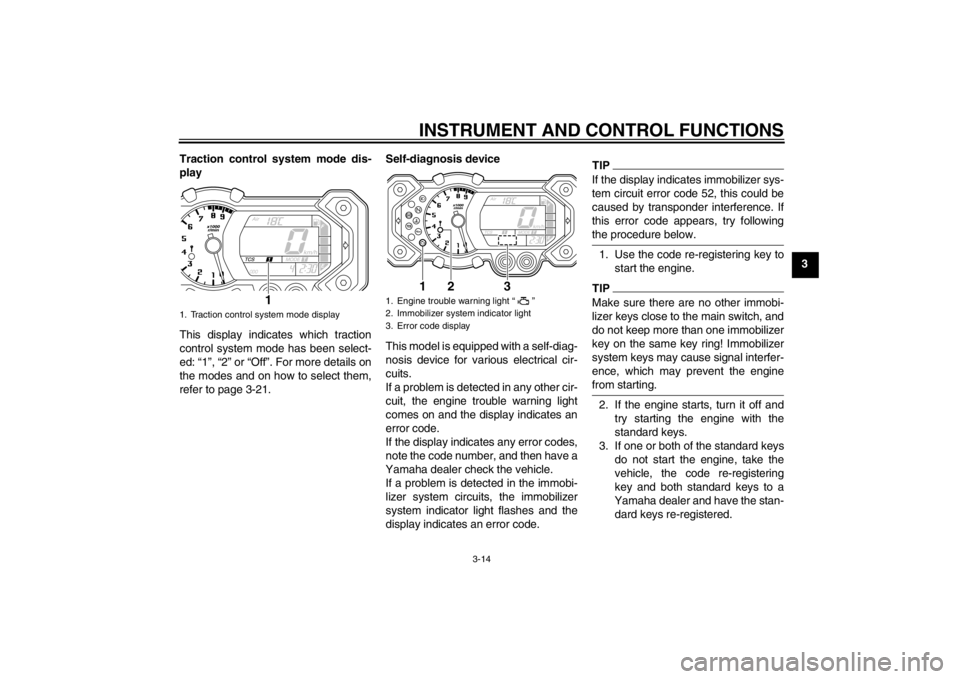
INSTRUMENT AND CONTROL FUNCTIONS
3-14
3
Traction control system mode dis-
play
This display indicates which traction
control system mode has been select-
ed: “1”, “2” or “Off”. For more details on
the modes and on how to select them,
refer to page 3-21. Self-diagnosis device
This model is equipped with a self-diag-
nosis device for various electrical cir-
cuits.
If a problem is detected in any other cir-
cuit, the engine trouble warning light
comes on and the display indicates an
error code.
If the display indicates any error codes,
note the code number, and then have a
Yamaha dealer check the vehicle.
If a problem is detected in the immobi-
lizer system circuits, the immobilizer
system indicator light flashes and the
display indicates an error code.
TIPIf the display indicates immobilizer sys-
tem circuit error code 52, this could be
caused by transponder interference. If
this error code appears, try following
the procedure below.1. Use the code re-registering key to
start the engine.TIPMake sure there are no other immobi-
lizer keys close to the main switch, and
do not keep more than one immobilizer
key on the same key ring! Immobilizer
system keys may cause signal interfer-
ence, which may prevent the engine
from starting.2. If the engine starts, turn it off andtry starting the engine with the
standard keys.
3. If one or both of the standard keys do not start the engine, take the
vehicle, the code re-registering
key and both standard keys to a
Yamaha dealer and have the stan- dard keys re-registered.
1. Traction control system mode display
1
1. Engine trouble warning light “ ”
2. Immobilizer system indicator light
3. Error code display
3
1
2
U23PE3E0.book Page 14 Monday, July 30, 2012 8:44 AM
Page 30 of 108
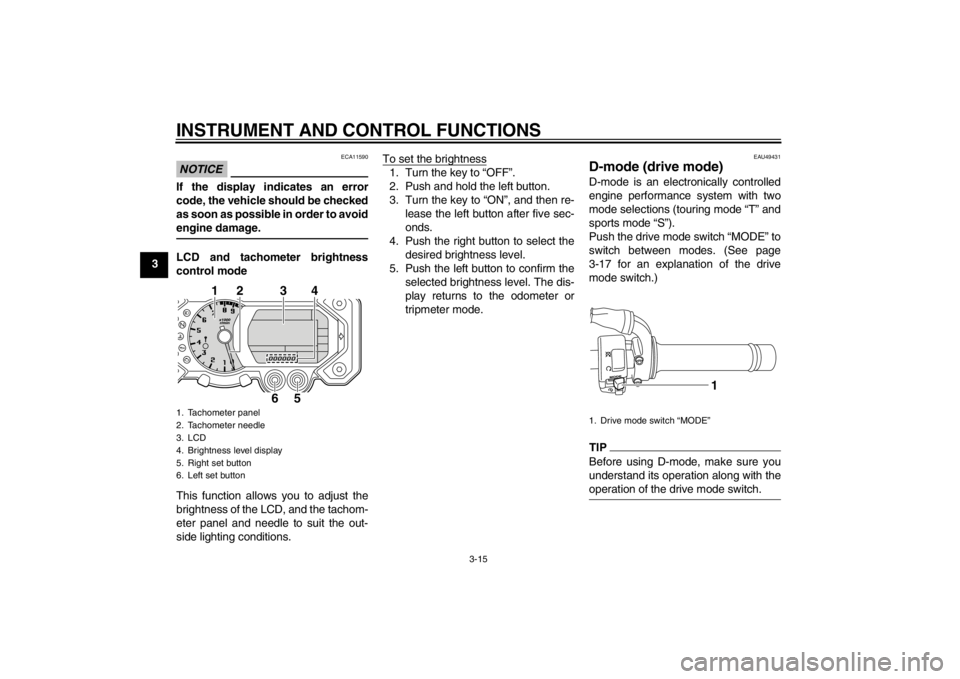
INSTRUMENT AND CONTROL FUNCTIONS
3-15
3
NOTICE
ECA11590
If the display indicates an error
code, the vehicle should be checked
as soon as possible in order to avoid
engine damage.LCD and tachometer brightness
control mode
This function allows you to adjust the
brightness of the LCD, and the tachom-
eter panel and needle to suit the out-
side lighting conditions.To set the brightness
1. Turn the key to “OFF”.
2. Push and hold the left button.
3. Turn the key to “ON”, and then re-
lease the left button after five sec-
onds.
4. Push the right button to select the desired brightness level.
5. Push the left button to confirm the selected brightness level. The dis-
play returns to the odometer or
tripmeter mode.
EAU49431
D-mode (drive mode) D-mode is an electronically controlled
engine performance system with two
mode selections (touring mode “T” and
sports mode “S”).
Push the drive mode switch “MODE” to
switch between modes. (See page
3-17 for an explanation of the drive
mode switch.)TIPBefore using D-mode, make sure you
understand its operation along with the
operation of the drive mode switch.
1. Tachometer panel
2. Tachometer needle
3. LCD
4. Brightness level display
5. Right set button
6. Left set button
1
2
3
4
6
5
1. Drive mode switch “MODE”
1
U23PE3E0.book Page 15 Monday, July 30, 2012 8:44 AM
Page 37 of 108
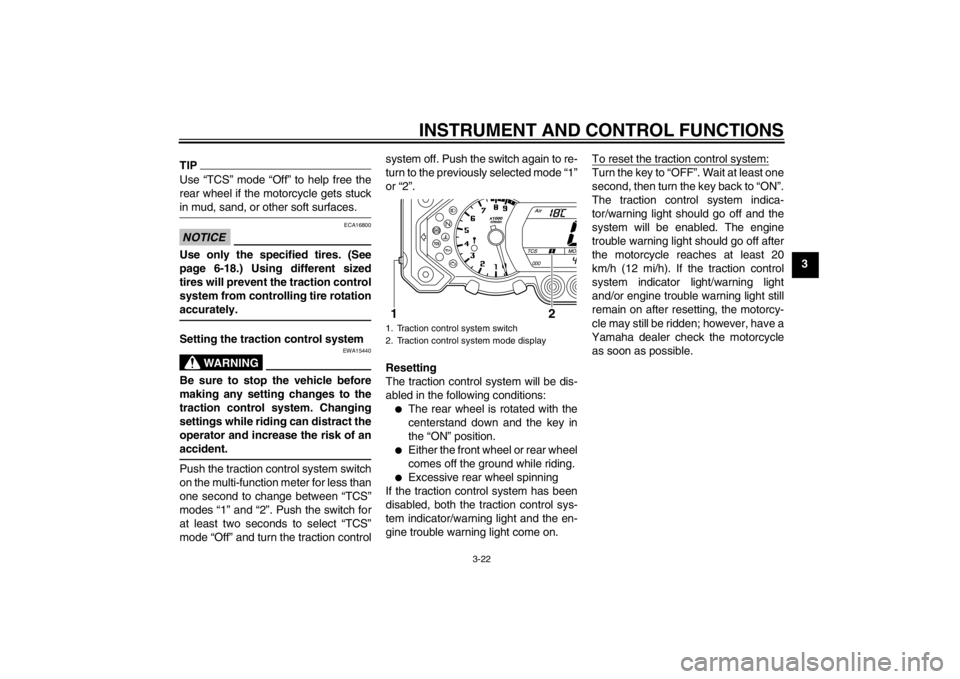
INSTRUMENT AND CONTROL FUNCTIONS
3-22
3
TIPUse “TCS” mode “Off” to help free the
rear wheel if the motorcycle gets stuck
in mud, sand, or other soft surfaces.NOTICE
ECA16800
Use only the specified tires. (See
page 6-18.) Using different sized
tires will prevent the traction control
system from controlling tire rotation
accurately.Setting the traction control system
WARNING
EWA15440
Be sure to stop the vehicle before
making any setting changes to the
traction control system. Changing
settings while riding can distract the
operator and increase the risk of an
accident.Push the traction control system switch
on the multi-function meter for less than
one second to change between “TCS”
modes “1” and “2”. Push the switch for
at least two seconds to select “TCS”
mode “Off” and turn the traction controlsystem off. Push the switch again to re-
turn to the previously selected mode “1”
or “2”.
Resetting
The traction control system will be dis-
abled in the following conditions:
●
The rear wheel is rotated with the
centerstand down and the key in
the “ON” position.
●
Either the front wheel or rear wheel
comes off the ground while riding.
●
Excessive rear wheel spinning
If the traction control system has been
disabled, both the traction control sys-
tem indicator/warning light and the en-
gine trouble warning light come on. To reset the traction control system:
Turn the key to “OFF”. Wait at least one
second, then turn the key back to “ON”.
The traction control system indica-
tor/warning light should go off and the
system will be enabled. The engine
trouble warning light should go off after
the motorcycle reaches at least 20
km/h (12 mi/h). If the traction control
system indicator light/warning light
and/or engine trouble warning light still
remain on after resetting, the motorcy-
cle may still be ridden; however, have a
Yamaha dealer check the motorcycle
as soon as possible.
1. Traction control system switch
2. Traction control system mode display
2
1
U23PE3E0.book Page 22 Monday, July 30, 2012 8:44 AM
Page 54 of 108
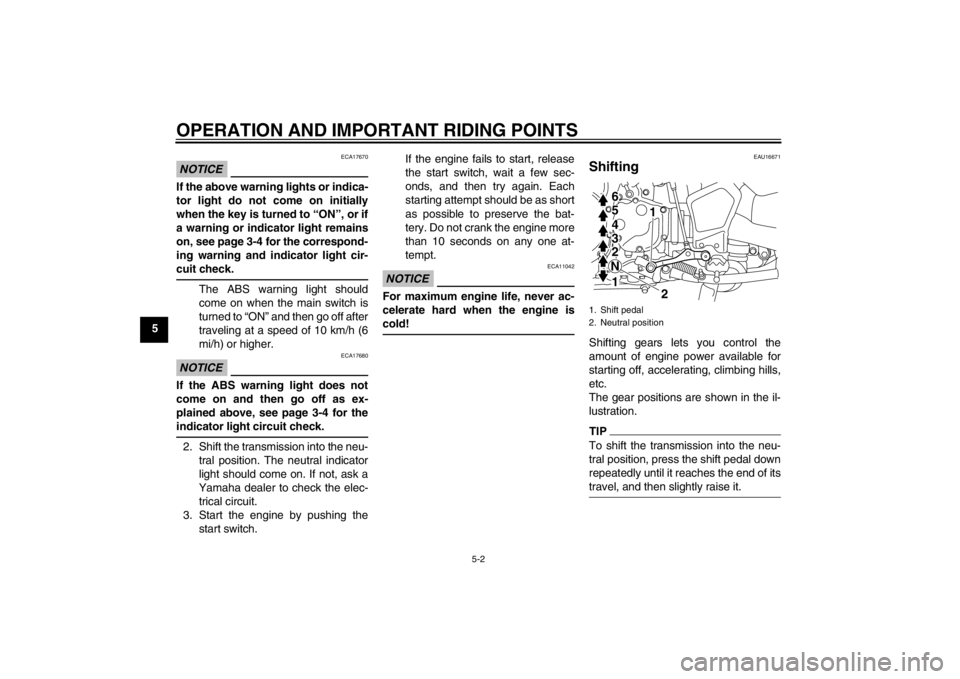
OPERATION AND IMPORTANT RIDING POINTS
5-2
5
NOTICE
ECA17670
If the above warning lights or indica-
tor light do not come on initially
when the key is turned to “ON”, or if
a warning or indicator light remains
on, see page 3-4 for the correspond-
ing warning and indicator light cir-
cuit check.
The ABS warning light should
come on when the main switch is
turned to “ON” and then go off after
traveling at a speed of 10 km/h (6
mi/h) or higher.
NOTICE
ECA17680
If the ABS warning light does not
come on and then go off as ex-
plained above, see page 3-4 for the
indicator light circuit check.2. Shift the transmission into the neu-tral position. The neutral indicator
light should come on. If not, ask a
Yamaha dealer to check the elec-
trical circuit.
3. Start the engine by pushing the start switch. If the engine fails to start, release
the start switch, wait a few sec-
onds, and then try again. Each
starting attempt should be as short
as possible to preserve the bat-
tery. Do not crank the engine more
than 10 seconds on any one at-
tempt.
NOTICE
ECA11042
For maximum engine life, never ac-
celerate hard when the engine is
cold!
EAU16671
Shifting Shifting gears lets you control the
amount of engine power available for
starting off, accelerating, climbing hills,
etc.
The gear positions are shown in the il-
lustration.TIPTo shift the transmission into the neu-
tral position, press the shift pedal down
repeatedly until it reaches the end of its
travel, and then slightly raise it.1. Shift pedal
2. Neutral position
1
2
654321N
U23PE3E0.book Page 2 Monday, July 30, 2012 8:44 AM
Page 62 of 108

PERIODIC MAINTENANCE AND ADJUSTMENT
6-6
6
21*Rear suspension re-
lay arm and con-
necting arm
pivoting points Check operation.
√√√√
22 Engine oil Change.
Check oil level and vehicle for oil
leakage. √√√√√√
23 Engine oil filter car-
tridge Replace.
√√√
24 *Cooling system Check coolant level and vehicle
for coolant leakage. √√√√√
Change coolant. Every 3 years
25 Final gear oil Check oil level and vehicle for oil
leakage. √√ √
Change. √√√
26 *Front and rear brake
switches
Check operation.
√√√√√√
27 Moving parts and
cables
Lubricate.
√√√√√
28 *Throttle grip Check operation.
Check throttle grip free play, and
adjust if necessary.
Lubricate cable and grip housing. √√√√√
29 *Lights, signals and
switches Check operation.
Adjust headlight beam.
√√√√√√
NO. ITEM CHECK OR MAINTENANCE JOB
ODOMETER READING
ANNUAL
CHECK
1000 km
(600 mi) 10000 km
(6000 mi) 20000 km
(12000 mi) 30000 km
(18000 mi) 40000 km
(24000 mi)U23PE3E0.book Page 6 Monday, July 30, 2012 8:44 AM